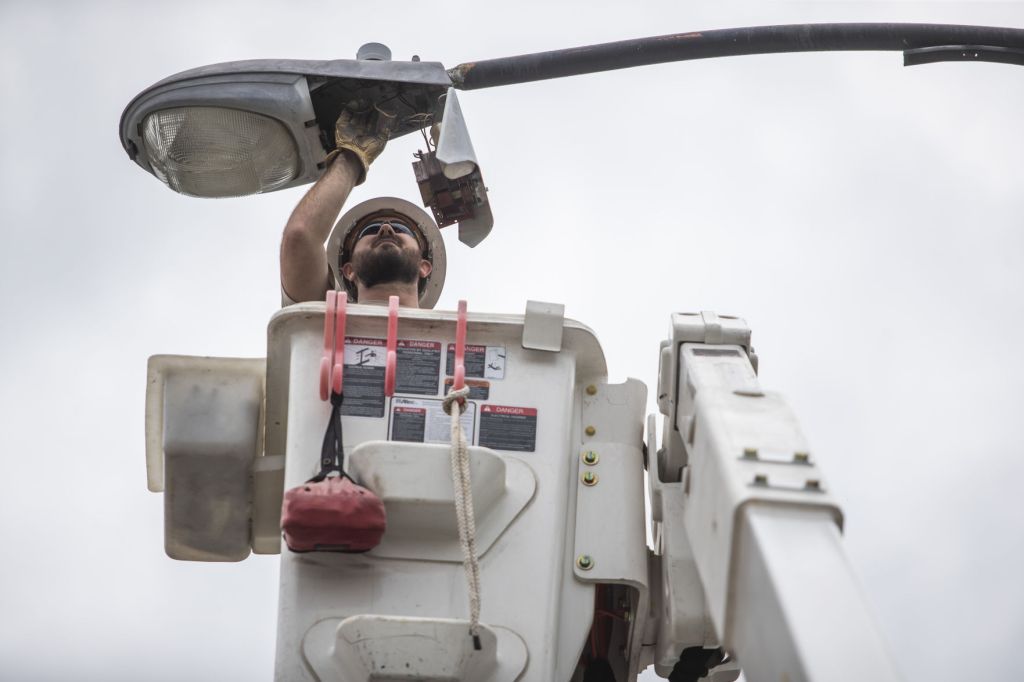BGMU gradually replacing city street lights with LEDs
Published 6:00 pm Friday, May 3, 2019

- BGMU lineman Chad Bullock removes a street light on Thursday, April 25, 2019, on College Street. (Austin Anthony/photo@bgdailynews.com)
Bowling Green Municipal Utilities is gradually replacing the city’s street lights, one burnout at a time.
Since the 1980s, BGMU has used high-pressure sodium vapor lights. In recent years, the utility and city met to determine the most efficient way to evolve the lighting system and decided to test LEDs, or light-emitting diodes. After about 100 test switches and positive resident feedback, BGMU began replacing essentially all failing street lights in January.
Of the 8,500 total street lights, BGMU has replaced about 500 fixtures thus far.
“We look at it as a long-term project,” said Jeff White, the BGMU electric system manager. “We’re not going to just go out and change fixtures just to change fixtures. … It could take us 10 to 12 years.”
LED lights are energy-efficient, require less maintenance and last longer. They don’t burn out like incandescent lights; instead, the brightness gradually dims. They’re also associated with fewer light outages, improved customer experience and more directional light, according to White.
There are two city costs for electricity: the wattage used and the investment charge for the cost of the fixture. The investment doesn’t change, but the wattage will reduce, according to Greg Meredith, director of Bowling Green Public Works.
“It’s good for everyone,” Meredith said of the project. “Long term, it’s going to make a big difference.”
Since LEDs create directional light, they have the potential to reduce light pollution. But some cities will add more lights with the cost savings associated with LEDs, thereby failing to reduce light pollution, according the International Dark Sky Association. The city of Bowling Green will keep the same number of lights.
Richard Gelderman, Western Kentucky University astronomy and physics professor and Hardin Planetarium director, believes there is a significant opportunity for the city to improve its lighting landscape.
“LED lights, if installed to produce the same amount of light as the street lights they replace, can not only save the city a significant amount of money but also reduce light pollution,” Gelderman said. “Badly designed lighting would really be a shame. These are fixtures that will be there for a long time.”
To achieve the best results, LED lights need to be the correct color and installed in efficient fixtures.
There are two types of LED lights widely circulated, including extra white “blue” lights and softer white lights. Short-wavelength blue light scatters farther in the atmosphere than long-wavelength red light or yellow-rich light, in the case of incandescents.
The blue LEDs “often end up making the situation worse” in multiple ways, Gelderman said. He cited the same reason people are advised to not use phones or tablets in the evening – or to at least turn off the blue lights in their devices – because it can affect circadian rhythms. Light pollution also disturbs the sleep-waking cycles of wildlife and prevents people from peering at night skies.
BGMU General Manager Mark Iverson indicated the utility would install softer LEDs to prevent this problem. “We’re trying to be cognizant of the lumens, and the light color that comes from it,” Iverson said.
As to the fixtures, BGMU will keep the new lights as similar to its predecessors as possible, including decorative lights.
On WKU’s campus and along the Operation P.R.I.D.E. corridor on Cemetery Road, there are light fixtures that look like ornamental glass globes. They are an example of what not to do, according to Gelderman.
“They are horrible examples of lighting, because they’re putting as much light in the air as they are down on the ground where it’s needed,” Gelderman said. “We shouldn’t be paying for light that isn’t going where it’s supposed to go.”
Iverson agreed that decorative lights are less efficient.
“It takes more of those glass globes than a more typical installation,” he said, but BGMU isn’t planning to remove decorative features. “We’re not going to put something in that doesn’t fit aesthetically. … Really, the only thing that’s changing out is the bulb fixture that is the actual light.”
BGMU hopes to improve lighting while pleasing customers, and “the feedback is that people like the light,” Iverson said.
Gelderman, though, has seen some of the initial installations and is not as pleased.
“I was hoping they would do better,” he said.






